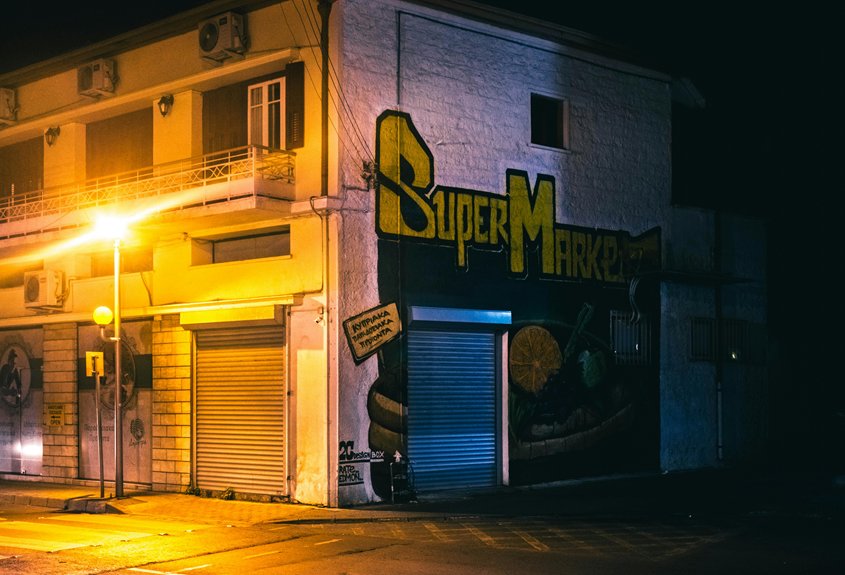Nicosia’s Venetian walls, once a medieval defense system, now symbolize Cyprus’s profound ethnic division. You’ll find these historic fortifications slicing through the city, transforming from protective infrastructure to a UN-patrolled buffer zone between Greek and Turkish Cypriot territories. They’re not just stones, but a physical manifestation of decades-long political tensions, marking a landscape where architectural heritage and contemporary conflict intersect. Curious about the deeper story?
Principales conclusiones
- The Venetian walls originally designed for medieval defense now symbolize the deep political and ethnic divisions between Greek and Turkish Cypriot communities in Cyprus.
- A UN-patrolled buffer zone (Green Line) literally runs through the historic walls, physically demarcating and reinforcing territorial separation since the 1974 conflict.
- Restricted checkpoints along the walls underscore the persistent mistrust and unresolved political tensions between the two communities, preventing free movement and integration.
- The walls have transformed from military infrastructure into a powerful political boundary, representing decades of failed reunification attempts and ongoing territorial disputes.
- Physical infrastructure of the walls continues to shape urban identity, cultural interactions, and intercommunal dynamics by maintaining a tangible reminder of historical fragmentation.
From Medieval Defense to Modern Division
Standing as a record of historical transformation, the Venetian walls of Nicosia illustrate a profound shift from medieval military architecture to a modern symbol of division. Originally constructed in the 16th century to protect the city from external threats, these fortifications have become an unintended marker of internal conflict. The Venetian walls, once designed for defense, now slice through Nicosia’s urban landscape, physically demarcating the boundary between Greek and Turkish Cypriot communities.
When the Turkish invasion occurred in 1974, these historic walls took on a new, unexpected role. The UN-patrolled buffer zone, known as the Green Line, now runs directly through the Venetian fortifications, turning what was once a unified defensive structure into a stark representation of Cyprus’s political fragmentation. You’ll find the divided city’s walls standing as a silent chronicle, affirmation, or record of decades of ethnic tension, their stones bearing witness to a complex narrative of separation and unresolved conflict.
The Strategic Geography of Walls and Borders
The geographical positioning of Nicosia’s Venetian walls reveals a complex interplay between physical infrastructure and political boundaries. You’ll find these 16th-century defensive structures shifting from their original military purpose, now serving as a critical UN-monitored buffer zone that physically separates Greek and Turkish Cypriot territories.
| Defensive Feature | Strategic Significance |
|---|---|
| Bastions | Natural high ground for territorial control |
| Moats | Physical obstacle preventing free movement |
| Wall Height | Provides clear visual and physical demarcation |
The walls’ strategic geography transforms an architectural artifact into a living geopolitical boundary. Their structural design, initially meant to repel external threats, now functions as an internal division marker. You can observe how these stone fortifications have seamlessly migrated from medieval defensive infrastructure to a contemporary political boundary, symbolizing the complex ethno-political tensions that have fragmented Nicosia since 1974. Their continued existence represents more than historical preservation-they’re a tangible manifestation of ongoing territorial dispute and unresolved community separation.
Political Tensions Etched in Stone
Although originally constructed as defensive fortifications, Nicosia’s Venetian walls now bear silent witness to decades of political fracture, their stone surfaces etched with the unresolved tensions of Cyprus’s complex ethno-political landscape. You’ll find these historic walls transformed from military defense to a stark symbol of division, literally cutting through the city’s historic heart and marking the contentious boundary between Greek and Turkish Cypriot territories.
The UN-patrolled buffer zone slicing through these centuries-old fortifications represents more than a geographical demarcation-it’s a physical manifestation of unresolved political conflict. Restricted checkpoints punctuate the walls, allowing limited crossings that underscore the deep-seated mistrust between communities. Failed reunification attempts like the 2004 Annan Plan further highlight how these stone barriers embody the seemingly intractable political stalemate.
Each weathered stone tells a story of separation, neglect, and the ongoing struggle to reconcile competing territorial claims.
UN Buffer Zone: A Living Monument of Conflict
How can a thin strip of land become a profound symbol of geopolitical complexity? The UN buffer zone in Cyprus transforms a mere 180 km stretch into a stark record of unresolved conflict. You’ll find this no-man’s land cutting through Nicosia, manned by UN peacekeepers, revealing abandoned buildings that whisper stories of division.
You’re witnessing a living monument where political and ethnic tensions crystallize into physical geography. The buffer zone isn’t just a boundary; it’s a breathing representation of Cyprus’s fractured identity. Crossing this divide isn’t a simple journey-it’s a bureaucratic navigation requiring paperwork and confronting the island’s painful partition.
Each meter of this zone represents more than territorial demarcation. It symbolizes decades of unresolved negotiations, community separation, and the persistent challenge of reconciliation. The buffer zone stands as a silent, unyielding reminder of how deeply political disputes can carve themselves into landscape and human experience.
Cultural Impacts of Urban Partition
Urban partitions cast long shadows beyond mere territorial lines, reshaping social landscapes and cultural identities. In Nicosia, you’ll witness how division transforms neighborhoods like Faneromeni into complex multicultural spaces, attracting marginalized groups and challenging traditional urban boundaries.
The Ledra Street checkpoint’s 2008 opening symbolizes this transformation, introducing nuanced intercommunal dynamics while simultaneously generating tensions between idealized ‘European city’ concepts and the city’s pluralistic reality. You’ll observe how government regeneration plans, like the €40 million Action Plan, potentially threaten the existing diverse community’s fabric by prioritizing aesthetic and developmental goals over social preservation.
The Venetian walls, once defensive structures, now serve as potent symbols of ongoing division. They bear witness to competing narratives about urban identity, where preservation efforts clash with contemporary multicultural realities. These historic boundaries continue to reflect Nicosia’s complex social architecture, demonstrating how physical partitions persistently shape cultural experiences and urban interactions.
Architectural Witnesses of Unresolved History
While architectural remnants often silently narrate historical conflicts, Nicosia’s Venetian walls dramatically embody the island’s unresolved political trauma. You’ll find these 16th-century fortifications standing as stark physical witnesses to decades of division, their bullet-scarred surfaces mapping the complex narrative of Cyprus’s fractured identity.
These walls, originally constructed to defend against Ottoman invasion, now symbolize a deeper conflict. Their positioning within the UN buffer zone underscores the tangible manifestation of ethnic tensions that have prevented national reunification. You can trace the green line’s impact through the walls’ damaged architecture, where each crumbling stone and bullet mark represents a moment of historical rupture.
The Venetian walls aren’t merely passive structures but active historical archives. They record the psychological scars of colonialism, nationalist struggles, and intercommunal conflict, transforming architectural heritage into a powerful chronicle of unresolved political dynamics that continue to shape Cyprus’s contested landscape.
Hopes and Challenges for Reunification
The persistent dream of Cypriot reunification remains entangled with complex geopolitical realities that have frustrated diplomatic efforts for decades. You’ll find the path to reunification fraught with significant challenges:
Cyprus: A tapestry of geopolitical complexities where reunification dreams collide with stubborn historical realities.
- Divergent political ideologies between Greek and Turkish Cypriot communities
- Ongoing territorial disputes and historical mistrust
- International diplomatic complications involving Turkey, Greece, and EU stakeholders
- Structural economic disparities between the two regions
You must recognize that reunification isn’t merely about physical barrier removal, but requires deep psychological reconciliation. The Venetian walls symbolize more than architectural boundaries-they represent decades of cultural separation and unresolved historical tensions.
Recent diplomatic initiatives offer cautious optimism. UN-sponsored negotiations and cross-border dialogue platforms have incrementally improved communication. However, substantial progress demands unprecedented political will, mutual compromise, and a shared vision transcending generational trauma.
Your understanding of reunification must embrace complexity, acknowledging that healing historical divisions requires patience, empathy, and strategic negotiation.
Preguntas frecuentes
Why Is Nicosia Divided?
You’ll find Nicosia divided due to the 1974 Turkish invasion following a Greek Cypriot nationalist coup. This conflict split the island, with Turkey occupying roughly 40% of Cyprus. The UN buffer zone now cuts through Nicosia’s heart, separating the Republic of Cyprus in the south from the Turkish Republic of Northern Cyprus in the north. Historic tensions and competing national identities have sustained this division for decades.
Why Is Cyprus Still Divided?
Like a wound that never heals, Cyprus remains divided due to deep-rooted ethnic tensions and unresolved territorial disputes. You’ll find the island split because of the 1974 Turkish invasion, ongoing disagreements over power-sharing, property rights, and troop presence. Repeated UN-mediated negotiations have failed to bridge the gap, leaving the Green Line a stark reminder of the complex historical and political divisions that continue to separate Greek and Turkish Cypriots.
Why Is There a No-Go Zone in Cyprus?
You’ll find the no-go zone in Cyprus exists due to the 1974 Turkish invasion, which forcibly divided the island. This UN-monitored buffer zone, stretching 180 km, prevents direct conflict between Greek and Turkish Cypriots. It’s a physical manifestation of decades-long ethnic tensions, where abandoned properties and military checkpoints symbolize the unresolved territorial dispute, effectively freezing the island’s political and social landscape since the partition.
Can You Go to Both Sides of Nicosia?
Yes, you can cross between the Greek and Turkish sides of Nicosia. The border is open, allowing Cypriots and visitors to move freely with passport or ID checks. While some residents are hesitant due to political sensitivities, younger generations regularly cross the buffer zone. You’ll navigate through UN-monitored checkpoints, passing barbed wire and abandoned buildings that reflect the city’s divided history.
Conclusión
You’ve walked through centuries of tension, tracing Nicosia’s Venetian walls-silent witnesses to division. Ironically, what once protected now segregates, transforming medieval defense into modern political barricade. The walls stand not just as stone, but as metaphors of unresolved conflict, challenging Cyprus’s identity. Despite their enduring presence, they whisper a complex narrative of hope: reunification might emerge from understanding the very boundaries that have long separated.

Natalie lleva 10 años viviendo en Chipre. Le encanta explorar la hermosa naturaleza de la isla, como sus tranquilos bosques y sus playas vírgenes. Natalie tiene muchas experiencias interesantes que compartir. Acompáñela y cuéntenos sus aventuras en Chipre.

